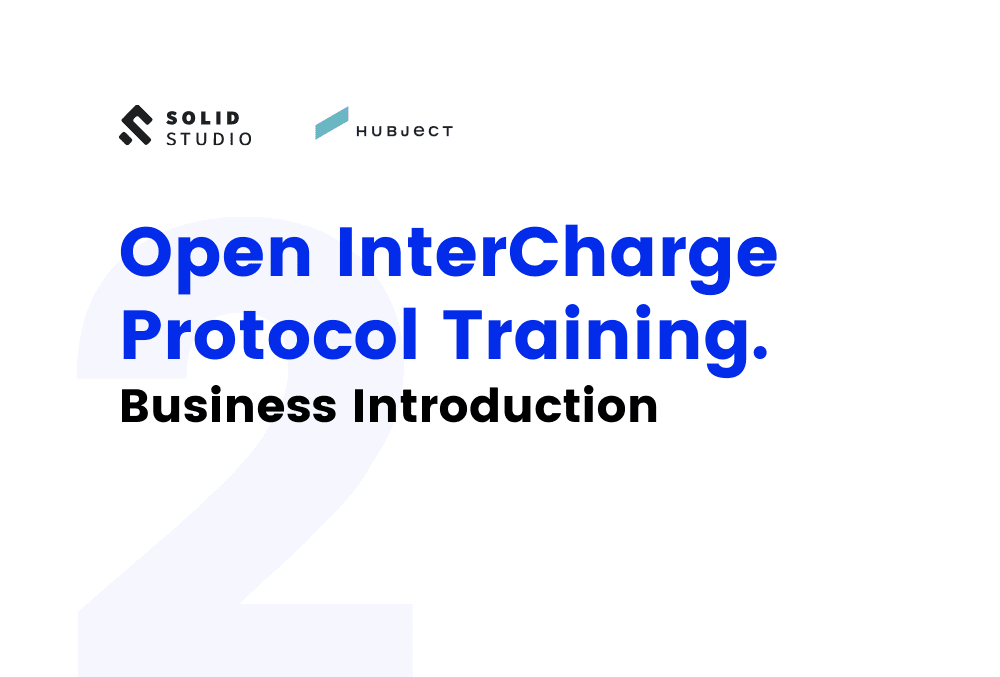Solidstudio is happy to introduce you to the Open Standards course led by our e-mobility expert - Bartlomiej. Throughout the following lessons, we will uncover the technicalities and functionalities of the OICP - a protocol developed by Hubject - as well as business aspects for e-Mobility Service Providers and Charge Point Operators.
Such a knowledge-pack should serve everyone operating in the e-mobility industry as it unfolds the most crucial aspects of navigating through Open Standards utilization and many more!
Subscribe to our YouTube channel to make sure you don't miss out on the upcoming training entries.
See the first lesson here!
Open InterCharge Protocol Training - Lesson 2
OICP Training Transcript
In this lesson, let's make an introduction into the business side of Hubject platform and processes that are behind. Even though from a developer perspective it may not seem to be important, it's good to know that and be aware of Hubject platform specifics.
Probably the most important business process is onboarding. It may differ a little bit between CPO and EMP so we will cover them both separately. According to Hubject, the typical onboarding may take from 10 weeks up to 12 weeks.
Onboarding CPO
The first phase in onboarding is the pre-contract phase. In this phase, you will share preliminary information, questionnaires, security requirements before signing a contract. Here you will also define your operator ID, generate CSR and white-list your server IP. Then, we have an onboarding start phase. It's basically a continuation of the pre-contract phase, but here you will receive RFID cards from Hubject for test purposes. The QA phase is all about implementation of services, configuration and testing integration. Then you will need to create a production environment and perform final tests with Hubject. That is a mandatory step before starting integrating with the Hubject platform. The last phase is the offer phase; as a CPO you may create an offer for other EMPs with detailed service specification and pricing.
Onboarding EMP
Onboarding EMP is very similar to onboarding CPO, there are just small little differences. In the pre-contract phase you will define your provider ID, as well as generate CSR and whitelist your server IP. In the onboarding start phase you are responsible for sending RFID cards to Hubject for test purposes. The QA phase and production ready phase are almost the same. Here you will implement services, configure them, perform integration tests, prepare production environment and perform final tests with Hubject. The last subscription phase is specific to EMP. Here you can subscribe to services offered by other CPOs. This step is mandatory in order to use the charging infrastructure offered by Hubject network. Normally, you as an EMP would like to subscribe to as many CPOs as possible, but be aware that each CPO may have different details, requirements and pricing for the same service type.
Service Offer
Service offers are created by CPO; they are used for modeling contract-based relationships between EMP and CPO partners. Service offer may be different depending on the CPO and can include individual details of some operations; i.e. different pricing per charging.
There are two types of service offers - offer to all and bilateral offer. The first one means that the offer is available to all EMP partners that wish to subscribe to it. In other words, any EMP that wishes to subscribe to it, must agree on common terms defined by CPO. The second one is a bilateral offer and it means that you can set a specific offer between EMP and CPO. That's very useful if you have an individual contract between those two and you still would like to use Hubject as your main communication platform.
Service configuration
In order to communicate, each service must be configured in the admin panel. For example: sometimes Hubject needs to communicate with your backend platform in order to perform some operations; i.e. authorization. Differently to OCPI, in OICP there is no endpoint structure or discoverability included in the standard. Only the message format is known to everyone. In order to start integrating with other partners, you need to provide some values i.e. service URL. Of course, each service may have different options to set. As you can see on this example, authorization service may have an option to specify whether you would like to process requests in online mode.
Subscribing to service offers
From EMP perspective, you would like to subscribe to service offers. In other words, you would like to have some kind of contract between you and CPO, in order to start using their charging infrastructure and offer it to your customers. That's exactly what is being done in the process of subscribing to service offers. In the Hubject platform you will see multiple offers for different services from different CPOs. Each offer will have individual terms, conditions and pricing. You need to take a look at the details and decide whether you can agree on them. If each partner implements a given service and EMP would agree on CPO terms, then both of them can start integration by subscribing to service offer.
Security
Security mechanism is rather simple. Any partner’s backend platform will communicate with Hubject via a secure connection. Security is based on SSL certificates and IP white-listing. SSL tunnel guarantees confidentiality via encryption, integrity via checksums and authenticity by using digital signatures and certificates. Reverse proxy will handle central https encryption and authentication of all incoming connections. Both reverse proxy and firewall provide access control by using white-lists which grant access only to the specific IP addresses.
Pricing types
In order to start integration between CPo and EMP, CPO must provide a pricing for an authorization service, then EMP may subscribe to the service and therefore its customers can use the charging infrastructure of a given CPO. There are four different types of pricings.
The first one and the most common one is standard pricing. It's a one simple price for all stations. It can be for example per hour, per minute or per kilowatt hours. Then, we have a pricing product which allows us to create multiple pricing products for stations i.e. we may have different pricing per sub-CPOs or different pricing per charging speed. Then, we have flexible pricing which is a slightly more complex version of pricing products. It allows us to create a set of complex business rules when it comes to the pricing. For example: we may define different pricing per EVSE, per location, per time or the combination of all above. It's also worth mentioning that EMP can pull pricing products in the same format; so it is understandable by both sides. Any pricing change needs to be presented before, for at least 42 days according to Hubject. Also, it's not recommended to change pricing very often, because EMP in the past agreed on some specific terms and conditions and now it needs to agree on the new one. The last type of pricing is dynamic pricing, which allows us to change pricing on a daily basis, but it's not so simple. It is allowed only for the bilateral offer between CPO and EMP because both sides need to agree on specific terms and conditions and their implementation must be prepared for that.
Intercharge Direct
Now we're gonna talk about solutions offered by Hubject, but which are not strictly connected with OICP protocol. The first one is intercharge Direct. In general, this solution allows customers to perform a direct payment to the CPO, without having any additional contract with EMP. This product is mostly intended for CPOs, as it increases their customer base. The flow looks very simple: the customer scans QR code at the charge point, then CPO specific website is loaded, the customer can then choose a specific charging product and payment provider after, that you may agree on terms and conditions, perform a final payment and then the charging session can be started. Of course, as a CPO you also need to perform some additional actions in order to configure that. Especially, you need to have a paypal or stripe payment provider account and also upload data needed for white labeling like logos or some custom messages.
Intercharge Settlement
Hubject also offers another service called intercharge Settlement. This service is supposed to automate the settlement process between CPO and EMP. It is built on the CDR Rating process, which calculates the final settlement based on product tariff and CPO tax configuration. Hubject will automatically initiate bank account transaction from EMP to CPO and create invoice. Of course, the first transaction from CPo to EMP is also possible in case anything goes wrong.
Of course, there are some requirements to be met. At first, you need to sign additional intercharge Settlement agreement. Then you need to have a bank account at a very specific bank EXFS, then you need to be fully onboarded on the Hubject platform and finally you need to successfully pass the validation process.

